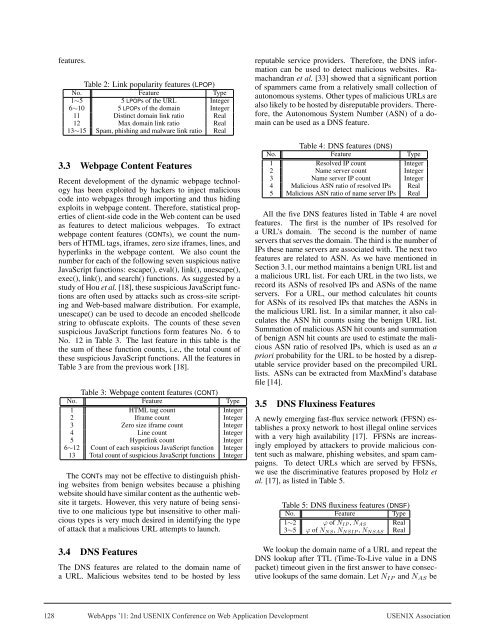2nd USENIX Conference on Web Application Development ...
2nd USENIX Conference on Web Application Development ...
2nd USENIX Conference on Web Application Development ...
Create successful ePaper yourself
Turn your PDF publications into a flip-book with our unique Google optimized e-Paper software.
features.<br />
Table 2: Link popularity features (LPOP)<br />
No. Feature Type<br />
1∼5 5 LPOPs of the URL Integer<br />
6∼10 5 LPOPs of the domain Integer<br />
11 Distinct domain link ratio Real<br />
12 Max domain link ratio Real<br />
13∼15 Spam, phishing and malware link ratio Real<br />
3.3 <strong>Web</strong>page C<strong>on</strong>tent Features<br />
Recent development of the dynamic webpage technology<br />
has been exploited by hackers to inject malicious<br />
code into webpages through importing and thus hiding<br />
exploits in webpage c<strong>on</strong>tent. Therefore, statistical properties<br />
of client-side code in the <strong>Web</strong> c<strong>on</strong>tent can be used<br />
as features to detect malicious webpages. To extract<br />
webpage c<strong>on</strong>tent features (CONTs), we count the numbers<br />
of HTML tags, iframes, zero size iframes, lines, and<br />
hyperlinks in the webpage c<strong>on</strong>tent. We also count the<br />
number for each of the following seven suspicious native<br />
JavaScript functi<strong>on</strong>s: escape(), eval(), link(), unescape(),<br />
exec(), link(), and search() functi<strong>on</strong>s. As suggested by a<br />
study of Hou et al. [18], these suspicious JavaScript functi<strong>on</strong>s<br />
are often used by attacks such as cross-site scripting<br />
and <strong>Web</strong>-based malware distributi<strong>on</strong>. For example,<br />
unescape() can be used to decode an encoded shellcode<br />
string to obfuscate exploits. The counts of these seven<br />
suspicious JavaScript functi<strong>on</strong>s form features No. 6 to<br />
No. 12 in Table 3. The last feature in this table is the<br />
the sum of these functi<strong>on</strong> counts, i.e., the total count of<br />
these suspicious JavaScript functi<strong>on</strong>s. All the features in<br />
Table 3 are from the previous work [18].<br />
Table 3: <strong>Web</strong>page c<strong>on</strong>tent features (CONT)<br />
No. Feature Type<br />
1 HTML tag count Integer<br />
2 Iframe count Integer<br />
3 Zero size iframe count Integer<br />
4 Line count Integer<br />
5 Hyperlink count Integer<br />
6∼12 Count of each suspicious JavaScript functi<strong>on</strong> Integer<br />
13 Total count of suspicious JavaScript functi<strong>on</strong>s Integer<br />
The CONTs may not be effective to distinguish phishing<br />
websites from benign websites because a phishing<br />
website should have similar c<strong>on</strong>tent as the authentic website<br />
it targets. However, this very nature of being sensitive<br />
to <strong>on</strong>e malicious type but insensitive to other malicious<br />
types is very much desired in identifying the type<br />
of attack that a malicious URL attempts to launch.<br />
3.4 DNS Features<br />
The DNS features are related to the domain name of<br />
a URL. Malicious websites tend to be hosted by less<br />
4<br />
reputable service providers. Therefore, the DNS informati<strong>on</strong><br />
can be used to detect malicious websites. Ramachandran<br />
et al. [33] showed that a significant porti<strong>on</strong><br />
of spammers came from a relatively small collecti<strong>on</strong> of<br />
aut<strong>on</strong>omous systems. Other types of malicious URLs are<br />
also likely to be hosted by disreputable providers. Therefore,<br />
the Aut<strong>on</strong>omous System Number (ASN) of a domain<br />
can be used as a DNS feature.<br />
Table 4: DNS features (DNS)<br />
No. Feature Type<br />
1 Resolved IP count Integer<br />
2 Name server count Integer<br />
3 Name server IP count Integer<br />
4 Malicious ASN ratio of resolved IPs Real<br />
5 Malicious ASN ratio of name server IPs Real<br />
All the five DNS features listed in Table 4 are novel<br />
features. The first is the number of IPs resolved for<br />
a URL’s domain. The sec<strong>on</strong>d is the number of name<br />
servers that serves the domain. The third is the number of<br />
IPs these name servers are associated with. The next two<br />
features are related to ASN. As we have menti<strong>on</strong>ed in<br />
Secti<strong>on</strong> 3.1, our method maintains a benign URL list and<br />
a malicious URL list. For each URL in the two lists, we<br />
record its ASNs of resolved IPs and ASNs of the name<br />
servers. For a URL, our method calculates hit counts<br />
for ASNs of its resolved IPs that matches the ASNs in<br />
the malicious URL list. In a similar manner, it also calculates<br />
the ASN hit counts using the benign URL list.<br />
Summati<strong>on</strong> of malicious ASN hit counts and summati<strong>on</strong><br />
of benign ASN hit counts are used to estimate the malicious<br />
ASN ratio of resolved IPs, which is used as an a<br />
priori probability for the URL to be hosted by a disreputable<br />
service provider based <strong>on</strong> the precompiled URL<br />
lists. ASNs can be extracted from MaxMind’s database<br />
file [14].<br />
3.5 DNS Fluxiness Features<br />
A newly emerging fast-flux service network (FFSN) establishes<br />
a proxy network to host illegal <strong>on</strong>line services<br />
with a very high availability [17]. FFSNs are increasingly<br />
employed by attackers to provide malicious c<strong>on</strong>tent<br />
such as malware, phishing websites, and spam campaigns.<br />
To detect URLs which are served by FFSNs,<br />
we use the discriminative features proposed by Holz et<br />
al. [17], as listed in Table 5.<br />
Table 5: DNS fluxiness features (DNSF)<br />
No. Feature Type<br />
1∼2 φ of NIP, NAS Real<br />
3∼5 φ of NNS, NNSIP, NNSAS Real<br />
We lookup the domain name of a URL and repeat the<br />
DNS lookup after TTL (Time-To-Live value in a DNS<br />
packet) timeout given in the first answer to have c<strong>on</strong>secutive<br />
lookups of the same domain. Let NIP and NAS be<br />
128 <strong>Web</strong>Apps ’11: <str<strong>on</strong>g>2nd</str<strong>on</strong>g> <str<strong>on</strong>g>USENIX</str<strong>on</strong>g> <str<strong>on</strong>g>C<strong>on</strong>ference</str<strong>on</strong>g> <strong>on</strong> <strong>Web</strong> Applicati<strong>on</strong> <strong>Development</strong> <str<strong>on</strong>g>USENIX</str<strong>on</strong>g> Associati<strong>on</strong>








